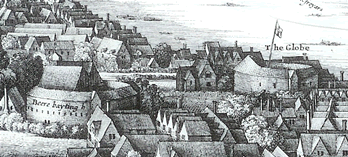The Globe Theatre that stands today in London is a faithful reconstruction of the venue where Shakespeare presented his plays. A 23-year project, the theatre's reconstruction brought together the work of historians, archaeologists, architects, engineers and actors as well as Sam Wanamaker, the American actor and producer who initiated and drove the project.
The planners sought to build an authentic theatre that closely modeled the original. In so doing, they wanted to ensure that the new Globe served as a working theater for scholars and actors - not simply as a museum.
The original Globe Theatre opened in 1599 in the Southwark area now called Bankside to the south of the Thames. The site covers 2200 square meters and is on the property of a building known as Anchor Terrace.
During the Elizabethan age, Southwark was an entertainment spot or red-light district. It boasted animal baiting, brothels, tanneries, breweries and lumberyards. Additionally, there were other theatres in the area such as the Swan, the Rose, and the Fortune, among others.
In 1613, the Globe burned down because of a canon used during a production of Henry VIII. The theatre was rebuilt and reopened the next year.
The Puritan Parliament later ordered the Globe officially closed in 1642. By 1644, it had been completely torn down and tenements were built in its place.
In 1989, after work on the new Globe had already begun, archaeologists discovered about 10 percent of the remains of the theatre’s original foundations beneath Anchor Terrace. Archaeologists also uncovered almost all of the Rose Theatre's foundations.
The Rose excavations revealed much more information than the Globe's dig. The Globe site had degraded significantly from the building of structures on top of it. But enough remained to reveal clues to the building materials and the configuration of the yard.
The new Globe, which opened in 1997, stands only 200 yards from the original site.
Since no blueprints of the original Globe exist, scholars had to piece together information for the design. They drew from a variety of sources:
 Planners also used Wenceslas Hollar's Long View of London from Bankside, a panoramic etching, to make inferences about the Globe’s design. The etching shows the second Globe of 1614, which was built on the foundations of the first.
Planners also used Wenceslas Hollar's Long View of London from Bankside, a panoramic etching, to make inferences about the Globe’s design. The etching shows the second Globe of 1614, which was built on the foundations of the first.
Though builders of today's Globe used modern construction techniques, they made every effort to use authentic materials. In fact, the Globe has the only thatched roof in the city - the first and only such roof since the Great Fire of 1666. Still, concessions were made to meet modern requirements. For instance, the new Globe has sprinklers, larger and more exits and a modern visitor center complete with bathrooms.
Future ChangesThe building Anchor Terrace stands atop the site of the original Globe Theatre. It cannot be further excavated, as Anchor Terrace is a protected historical site. However, Globe planners are confident that additional research and the hands-on experience of actors on the new stage will reveal more information about the theatre. Perhaps it could even lead to design modifications.